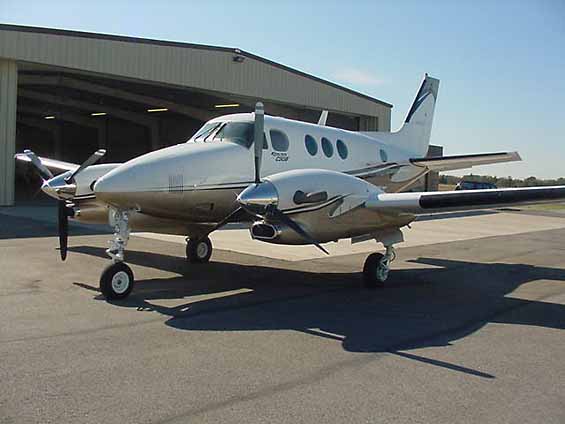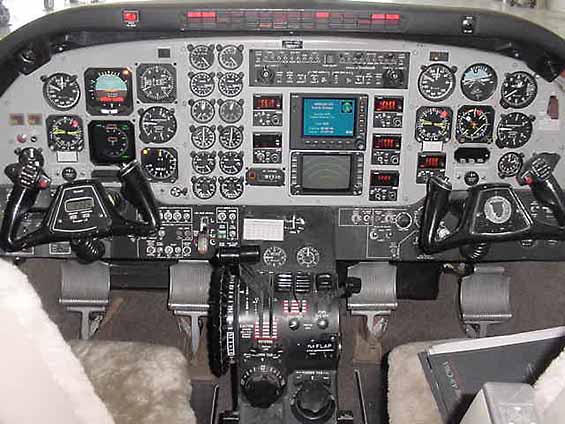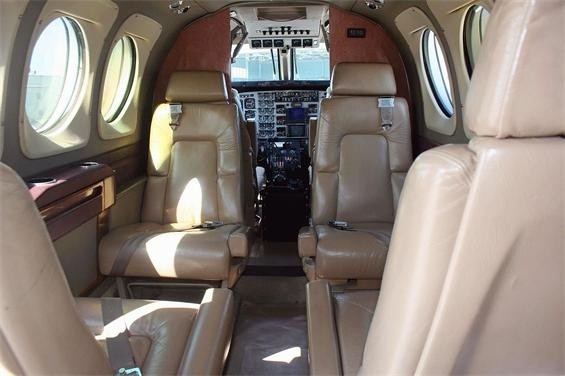


Aircraft Description
Background/History
In January 1964 the first Beechcraft 65-90 took to the air. Based on the piston-engined Model 65 Queen Air, the -90 featured the then-new Pratt & Whitney Canada PT6A turboprop powerplants in place of the earlier 65’s Lycoming IGSO-480-A1E6 flat-six piston engines. A pressurized model was developed, and was designated the King Air 90. Many variants followed including the PT6A-20-powered A90 and B90, and the C90 powered by the the PT6A-21. The C90A, introduced in 1984, incorporated an improved cowling design for more efficient air induction and reduced drag, an updated three-bus electrical system, hydraulically actuated landing gear, and Collins Pro Line avionics. In 1991 the C90A was replaced by the C90B with more speed, better airport performance and less cabin noise. Throughout its 14 year career the C90B was produced 441 times, until it was superceded by the C90GT in 2006, which is now called the C90GTI.
Power
The King Air C90B is powered by a pair of Pratt & Whitney Canada PT6A-21 reverse flow, axial-centrifugal turboprop engines flat-rated at 550shp at ISA +18 C, each driving a McCauley four-bladed, full-feathering, reversible, constant speed propeller. Engine inspection interval is 3,600 hours.
Avionics
The standard equipment package for the King Air C90B includes a Collins EFIS-84 two-tube system for the left side with a WXR-270 color weather radar and APS-65H autopilot with FIS-84 flight director, and Collins Pro Line II comm/nav/ident radios with DME. Options include a three-tube EFIS with either an EFD-84 radar or an MFD-85 multifunction display.
Design Features
The King Air C90B is a pressurized, twin-engine turboprop business aircraft configured as a cantilever low-wing monoplane with a conventional tail. It has retractable tricycle landing gear with a single wheel on each mount and an airstair door located aft of the wing on the port side of the fuselage. It utilizes dual bleed air pressurization and heat. The 90-inch four-bladed McCauley propellers provide substantially better airport performance and are dynamically balanced to reduce vibration and noise levels. Other steps taken to reduce the King Air’s notoriously high cabin noise levels include composite-material insulation panels and 26 dynamically-tuned vibration absorbers strategically placed throughout the fuselage frame.
Accomodations
The King Air C90B is configured for six passengers, with four seats arranged in a club, one seat across from the door, and a belted lavatory seat. Redesigned seats allow passengers to sit 1.5 in. farther back in the seat, which nets 3 in. additional legroom in the club compared to the C90A. The C90B also includes a sliding partition between the cabin and the flight deck. The aft cabin accommodates the lavatory seat and 26.5 cu.ft. of baggage area. As a result of dynamic vibration dampeners, new propellers, and improved acoustic insulation, noise levels in the C90B are as much as 15 dB lower than in previous King Air models. Internal cabin dimensions are 4.8ft. in height, 4.5ft. in width and 12.4ft. in length.
| General | King Air C90B, BE-C90B | |||
|---|---|---|---|---|
| Category | Multiengine Turboprop < 12,500 lbs. | |||
| Years Aircraft Manufactured | 1992 – 2006 | |||
| Serial Number Range | 1288-1692(up) | |||
| Retail High Price | $2,119,317.00 / 1,663,028.04€ | |||
| Retail Low Price | $849,500.00 / 666,602.65€ | |||
| Characteristics | King Air C90B, BE-C90B | |||
| Seating | 1+5/12 | |||
| Wing Loading | 34.4 | |||
| Power Loading | 9.2 | |||
| Noise(EPNdB): Takeoff/Sideline/Approach | 74.3 | |||
| External Dimensions (ft) | King Air C90B, BE-C90B | |||
| External Length | 35.5 | |||
| External Height | 14.3 | |||
| External Span | 50.3 | |||
| Internal Dimensions (ft) | King Air C90B, BE-C90B | |||
| Internal Length (Overall/Net Height) | 12.4/12.4 | |||
| Internal Height | 4.8 | |||
| Internal Width (Max/Floor) | 4.5/4.1 | |||
| Baggage | King Air C90B, BE-C90B | |||
| External: Cu.Ft./Lb. | 48.3/350 | |||
| External: Cu.Ft./Lb. | N/A | |||
| Power | King Air C90B, BE-C90B | |||
| Engines | 2 P&WC PT6A-21 | |||
| Output (lbs ea.)/Flat Rating | 550shp/ISA+18 | |||
| Inspection Interval | 3,600t | |||
| Data based on latest manufactured year | ||||



